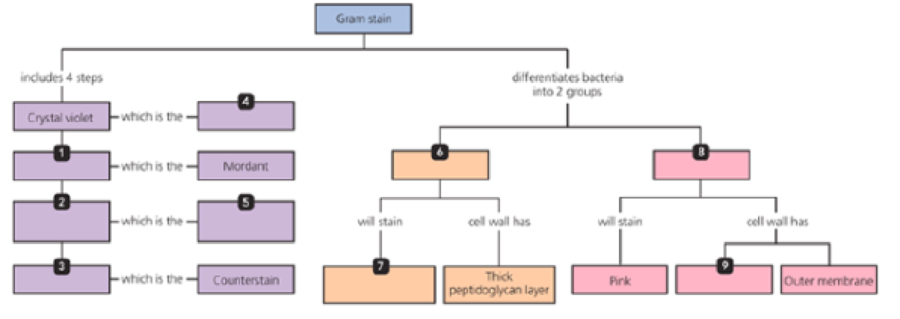
Microbiology with Diseases by Body System (4th Edition)
4th Edition
ISBN: 9780321918550
Author: Robert W. Bauman Ph.D.
Publisher: PEARSON
expand_more
expand_more
format_list_bulleted
Textbook Question
Chapter 4, Problem 1CM
Using the following terms, fill in the following concept map that describes
Decolorizer
Ethanol and acetone
Gram-negative bacteria
Gram-positive bacteria
Iodine
Primary stain
Purple
Safranin
Thin peptidoglycan layer

Expert Solution & Answer
Want to see the full answer?
Check out a sample textbook solution
Students have asked these similar questions
The following table is from Kumar et. al. Highly Selective Dopamine D3 Receptor (DR) Antagonists and Partial Agonists Based on Eticlopride and the D3R Crystal Structure: New Leads for Opioid Dependence Treatment. J. Med Chem 2016.
The following figure is from Caterina et al. The capsaicin receptor: a heat activated ion channel in the
pain pathway. Nature, 1997. Black boxes indicate capsaicin, white circles indicate resinferatoxin.
You are a chef in a fancy new science-themed restaurant. You have a recipe that calls for 1 teaspoon of resinferatoxin, but you feel uncomfortable serving foods with "toxins" in them. How much capsaicin could you substitute instead?
What protein is necessary for packaging acetylcholine into synaptic vesicles?
Chapter 4 Solutions
Microbiology with Diseases by Body System (4th Edition)
Ch. 4 - Prob. 1TMWCh. 4 - Why is a Gram-negative bacterium colorless but a...Ch. 4 - Why didnt Linnaeus create taxonomic groups for...Ch. 4 - Necrotizing Fasciitis Fever, chills, nausea,...Ch. 4 - Why is magnification high and color absent in an...Ch. 4 - Prob. 1MCCh. 4 - Prob. 2MCCh. 4 - Prob. 3MCCh. 4 - Curved glass lenses _________ light. a. refract b....Ch. 4 - Prob. 5MC
Ch. 4 - Prob. 6MCCh. 4 - Prob. 7MCCh. 4 - Prob. 8MCCh. 4 - Prob. 9MCCh. 4 - In the binomial system at nomenclature, which term...Ch. 4 - Prob. 1FIBCh. 4 - Prob. 2FIBCh. 4 - Prob. 3FIBCh. 4 - Fill in the Blanks 4. ___________ refers to...Ch. 4 - Fill in the Blanks 5. Cationic chromophores such...Ch. 4 - Prob. 1VICh. 4 - Label the microscope.Ch. 4 - Prob. 1SACh. 4 - Critique the following definition of magnification...Ch. 4 - Prob. 3SACh. 4 - Put the following substances in the order they are...Ch. 4 - Prob. 5SACh. 4 - Prob. 6SACh. 4 - Prob. 7SACh. 4 - Prob. 8SACh. 4 - Miki came home from microbiology lab with green...Ch. 4 - Why is the definition of species as successfully...Ch. 4 - With the exception of the discovery of new...Ch. 4 - Prob. 4CTCh. 4 - Prob. 5CTCh. 4 - In what ways are the Gram stain and the acid-fast...Ch. 4 - Prob. 7CTCh. 4 - Prob. 8CTCh. 4 - Why is the genus name Coccus placed within...Ch. 4 - A clinician obtains a specimen of urine from a...Ch. 4 - Using the following terms, fill in the following...
Knowledge Booster
Learn more about
Need a deep-dive on the concept behind this application? Look no further. Learn more about this topic, biology and related others by exploring similar questions and additional content below.Similar questions
- 1. Match each vocabulary term to its best descriptor A. affinity B. efficacy C. inert D. mimic E. how drugs move through body F. how drugs bind Kd Bmax Agonist Antagonist Pharmacokinetics Pharmacodynamicsarrow_forward50 mg dose of a drug is given orally to a patient. The bioavailability of the drug is 0.2. What is the volume of distribution of the drug if the plasma concentration is 1 mg/L? Be sure to provide units.arrow_forwardDetermine Kd and Bmax from the following Scatchard plot. Make sure to include units.arrow_forward
- Choose a catecholamine neurotransmitter and describe/draw the components of the synapse important for its signaling including synthesis, packaging into vesicles, receptors, transporters/degradative enzymes. Describe 2 drugs that can act on this system.arrow_forwardThe following figure is from Caterina et al. The capsaicin receptor: a heat activated ion channel in the pain pathway. Nature, 1997. Black boxes indicate capsaicin, white circles indicate resinferatoxin. a) Which has a higher potency? b) Which is has a higher efficacy? c) What is the approximate Kd of capsaicin in uM? (you can round to the nearest power of 10)arrow_forwardWhat is the rate-limiting-step for serotonin synthesis?arrow_forward
arrow_back_ios
SEE MORE QUESTIONS
arrow_forward_ios
Recommended textbooks for you
 Microbiology for Surgical Technologists (MindTap ...BiologyISBN:9781111306663Author:Margaret Rodriguez, Paul PricePublisher:Cengage Learning
Microbiology for Surgical Technologists (MindTap ...BiologyISBN:9781111306663Author:Margaret Rodriguez, Paul PricePublisher:Cengage Learning Comprehensive Medical Assisting: Administrative a...NursingISBN:9781305964792Author:Wilburta Q. Lindh, Carol D. Tamparo, Barbara M. Dahl, Julie Morris, Cindy CorreaPublisher:Cengage Learning
Comprehensive Medical Assisting: Administrative a...NursingISBN:9781305964792Author:Wilburta Q. Lindh, Carol D. Tamparo, Barbara M. Dahl, Julie Morris, Cindy CorreaPublisher:Cengage Learning




Microbiology for Surgical Technologists (MindTap ...
Biology
ISBN:9781111306663
Author:Margaret Rodriguez, Paul Price
Publisher:Cengage Learning


Comprehensive Medical Assisting: Administrative a...
Nursing
ISBN:9781305964792
Author:Wilburta Q. Lindh, Carol D. Tamparo, Barbara M. Dahl, Julie Morris, Cindy Correa
Publisher:Cengage Learning
Serology 101: Testing for IgG and IgM antibodies; Author: Beckman Coulter Dx;https://www.youtube.com/watch?v=LtqKB-qpJrs;License: Standard youtube license